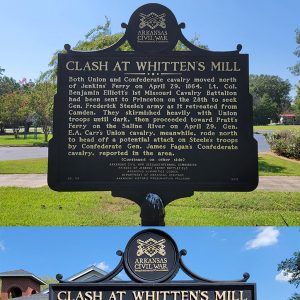calsfoundation@cals.org
Skirmish at Whitmore's Mill
aka: Skirmish at Whitten's Mill
| Location: | Grant County |
| Campaign: | Camden Expedition |
| Date: | April 30, 1864 |
| Principal Commanders: | Unidentified (US); Lieutenant Colonel Benjamin Elliott (CS) |
| Forces Engaged: | Unidentified (US); First Missouri Cavalry Battalion (CS) |
| Estimated Casualties: | None reported (US); None reported (CS) |
| Results: | Confederate victory |
Fought on the same day as the Engagement at Jenkins’ Ferry (April 30, 1864), the Skirmish at Whitmore’s Mill took place in Grant County as part of the larger Camden Expedition.
On April 28, 1864, Brigadier General Joseph Orville Shelby ordered Lieutenant Colonel Benjamin Elliott and the First Missouri Cavalry Battalion (CS) to reconnoiter in and around the village of Princeton (Dallas County) to ascertain if all of Major General Frederick Steele’s force had left Camden (Ouachita County).
Elliott began his operation by sending First Lieutenant W. B. Walker and Company B toward Princeton, with orders to report as soon as possible. Elliott also sent scouting parties on the roads leading from Tulip (Dallas County) to Princeton. Elliott arrived at Tulip with the remainder of his command around 11:30 a.m., when he halted and waited for incoming reports.
Captain Robert J. Tucker of Company A reported first, indicating heavy skirmishing with Federals. Elliott ordered the rest of Tucker’s company to reinforce and hold the position if possible, but Tucker was initially compelled to withdraw. Nonetheless, Elliott regained the position when he reinforced it with three companies. Elliott managed to hold this position until dark.
That evening, Walker reported movement of Steele’s entire force. Elliott pursued with a march until 4:00 p.m. on April 29, when his men arrived at Pratt’s Ferry in Grant County. They could not obtain local information about the location of Brigadier General James Fagan’s force, so Elliott crossed the Saline River to collect forage.
On April 30, a force of approximately 2,000 Federals arrived at what they misidentified as Whitmore’s Mill, about four miles from Elliott’s camp along the Saline River. (The mill was actually owned by one David Whitten.) A scouting party of approximately 150 Federal troops drove Elliott’s pickets back to camp. Reinforced by two companies, Elliott’s Battalion dispersed the Federal scouting party into general flight. According to Elliott, the Federals mistook his force for Fagan’s entire command. During their ensuing withdrawal, the Federals burned much of their own supply train, destroying at least 200 wagons.
On May 1, Elliott sent scouts on roads leading from the Benton and Pratt’s Ferry Road to the Little Rock and Jenkins’ Ferry Road, driving in Federal pickets at every turn. Elliott also sent Captain W. W. Greenwood’s Company F to attack Federal foraging parties heading to Little Rock (Pulaski County), which Greenwood promptly routed. Elliott continued to pursue this force from the rear until May 2, during which time they continued to burn their own wagons, until within twenty miles of Little Rock. At this point, Elliott turned toward Benton (Saline County) and Pratt’s Ferry. At Pratt’s Ferry, Elliott received orders to rejoin Shelby’s Brigade. Elliott suggested to his superiors that much of the Federal wagon train was burned hastily and could be recovered or repaired.
Along with skirmishes fought at Princeton, the Ouachita River crossing, and Saline Bottoms, this skirmish stands as one of the most severe skirmishes of the Camden Expedition prior to the Engagement at Jenkins’ Ferry. No casualty figures for either side are published for the Skirmish at Whitmore’s Mill.
For additional information:
Sellmeyer, Deryl P. Jo Shelby’s Iron Brigade. Gretna, LA: Pelican Publishing Company, 2007.
The War of the Rebellion: A Compilation of the Official Records of the Union and Confederate Armies. Series 1, Vol. 34, part 1. Washington DC: Government Printing Office, 1891.
Robert Patrick Bender
Eastern New Mexico University–Roswell
 ACWSC Logo
ACWSC Logo  Whitten's Mill Marker
Whitten's Mill Marker 



The name Whitmore’s Mill was erroneously given by Union soldiers. The mill’s owner and operator, David Whitten, was a resident of what was then Saline County and ran the only steam-powered mill in the county. Parts of the machinery were recovered and are in the Grant County Museum.